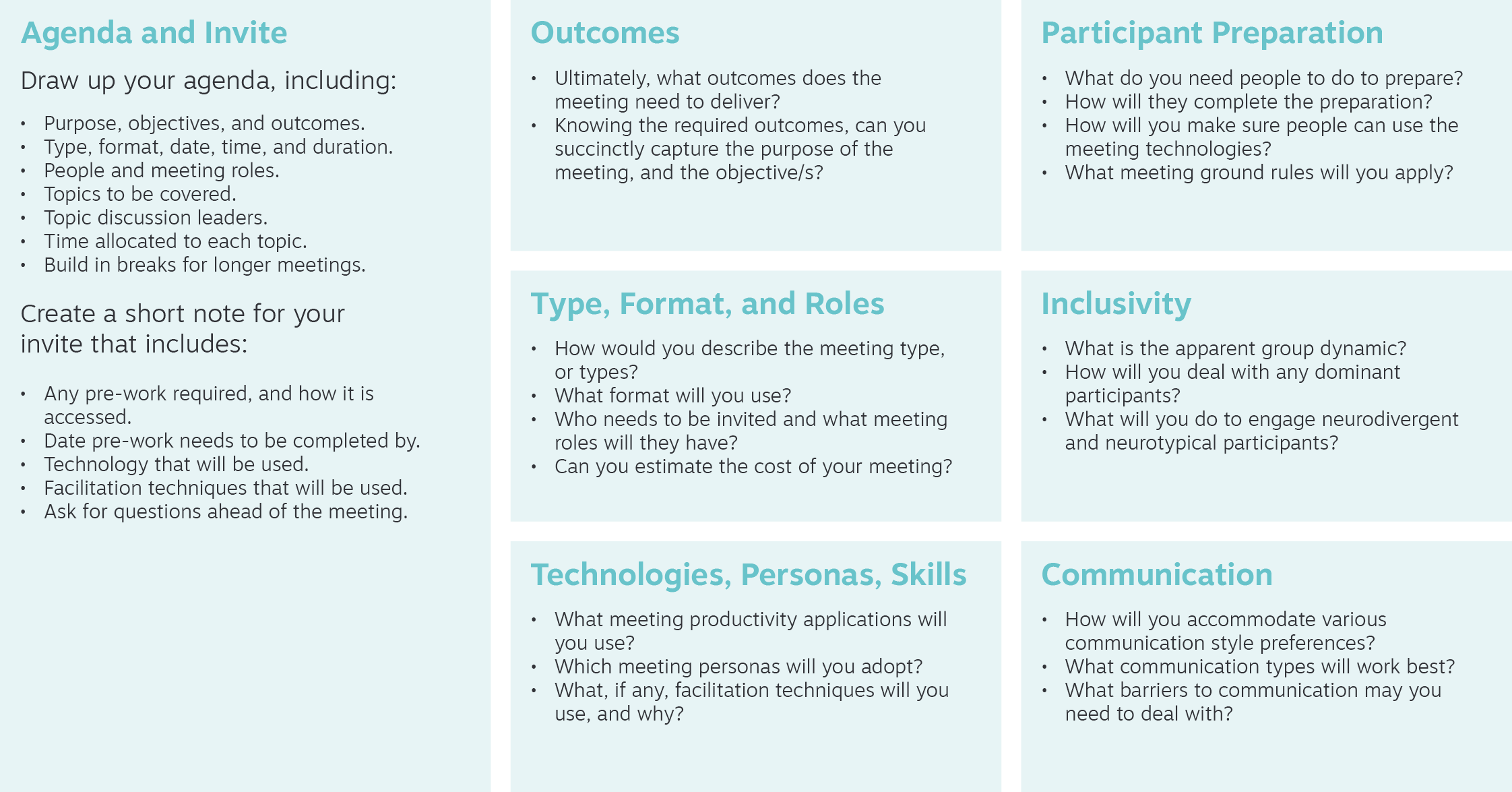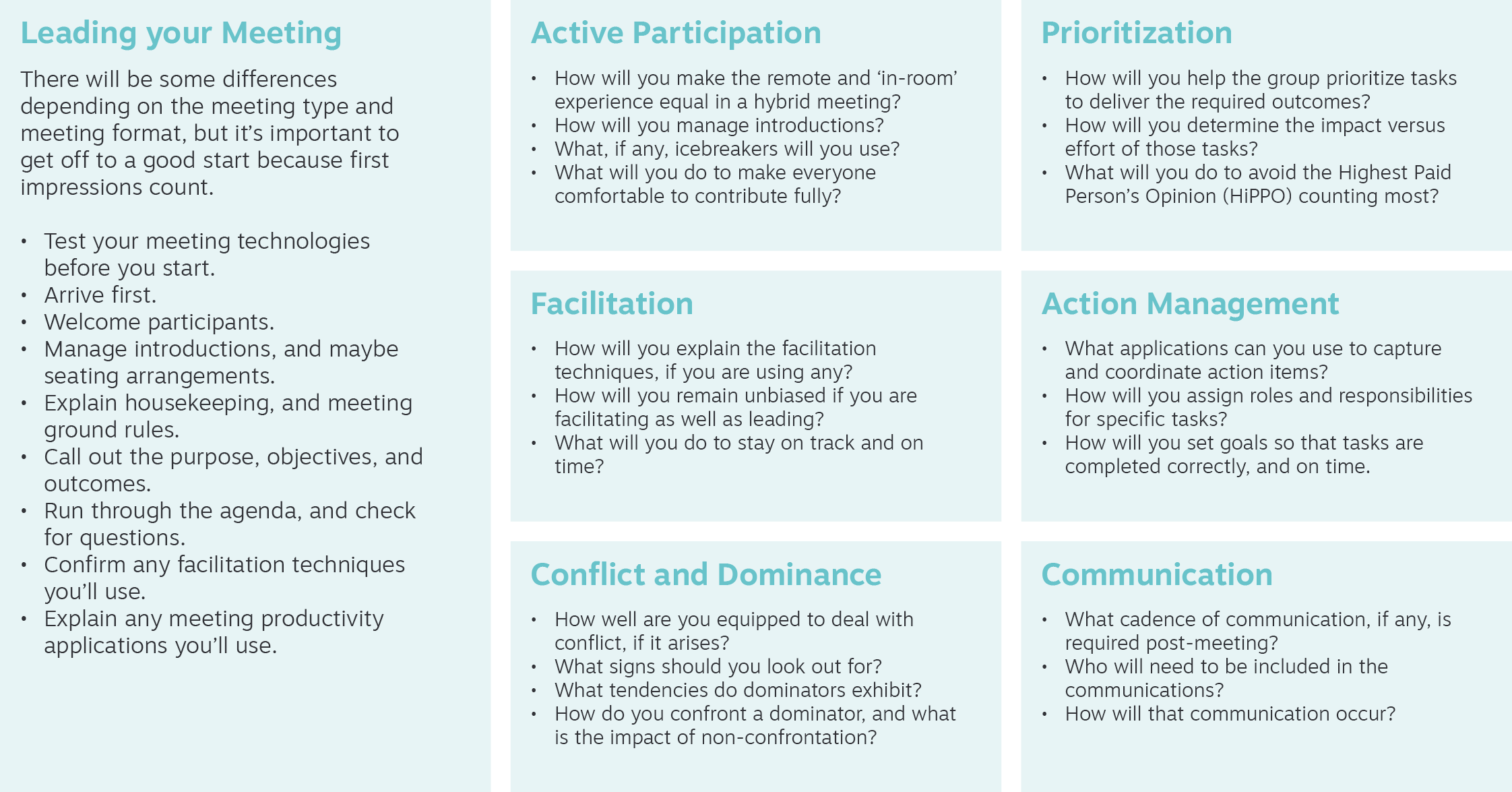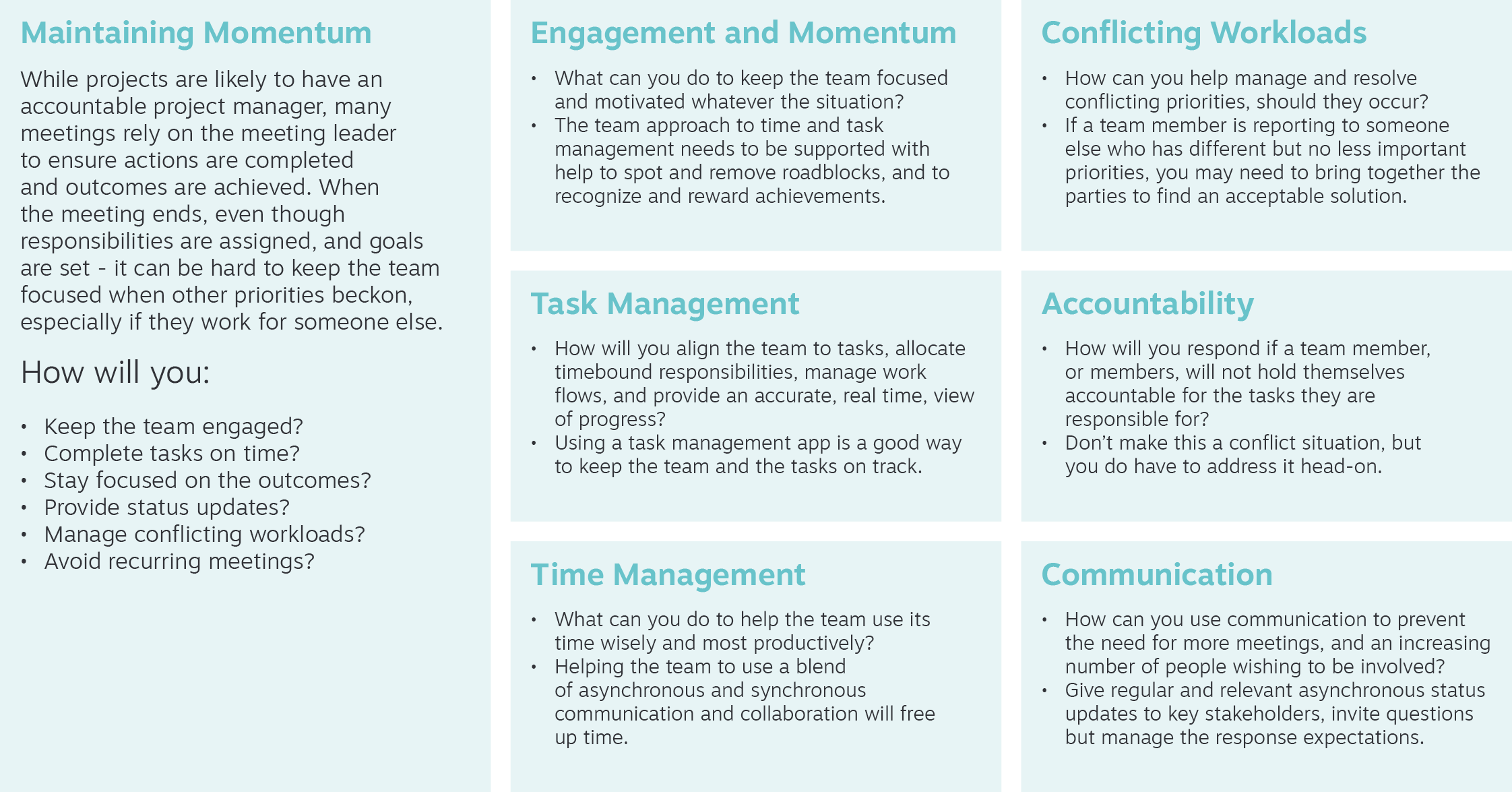Previously we said that the term leader persona describes the role characteristics that a meeting leader intentionally assumes, during the various meeting phases, to support the meeting participants to achieve a common goal.
We’ve briefly discussed 6 personas that can be used individually, or in combination, depending on the meeting type.
You’ll find a card for each persona in your deck. Those cards call out the top qualities for each persona, along with their specific focus areas.
Let’s consider how we incorporate various personas when designing a meeting. We do this in the context of the Meeting Type or types, the Meeting Format, and the Meeting Roles, all of which are aligned with the meeting’s purpose, objectives, and outcomes.
The 6 Meeting Leader Personas
Here’s a reminder of the 6 personas. Click on the tiles to reveal the descriptions...
Collaborator
Creating an inclusive meeting culture of teamwork.
Communicator
Engaging others through the power of clear communication.
Educator
Empowering the sharing of knowledge and skills.
Facilitator
Providing resources to achieve group objectives.
Innovator
Encouraging new ideas to solve problems and create opportunities.
Invigorator
Creating energy and sustaining the group’s enthusiasm.
Using an example...
So, we’ve determined we need a meeting, so let’s start with the purpose, objectives, and outcomes.
Well use the home page design example that you’ve seen before. You can refresh your memory by going back into the Meeting Design section of the card deck.
This meeting will generate new homepage ideas. That’s the purpose. From those ideas we’ll create three draft homepage layouts. Those draft layouts are the objectives. And we anticipate we’ll agree a final design. That’s the expected outcome.
As meeting leader, you may have a dual role of leader and facilitator, or in some instances you may have an independent facilitator supporting you. Let’s assume you have a dual role as that’s a common occurrence.
We consider the personas that we anticipate we’ll need to use during the Plan and Prepare steps. Canvas #1: Pre-meeting Design guides you through this.

We know that this will be a compound meeting, meaning we need to bring various meeting types together. The Meeting Types will be information-sharing, ideation and innovation, and decision-making.
Ahead of the meeting, along with the invite and agenda, we’ll share some pre-meeting information. That’ll give people the time to read, digest, and question the research we’ve done on the shortcomings of the existing home page design, and it’ll allow us to use the in-meeting time to deliver the objectives and outcomes.
We’ll be using various techniques, which we refer to as Skills, to help the group with ideation, and decision support. Therefore, the identified personas must support the facilitation of those activities. You’ll find information about facilitation techniques, and how to use them, in the Skills section.
Note: When planning the personas that you’ll adopt for a specific meeting, consider breaking them down into primary and secondary personas. Primary personas are the ones you know you will need, while secondary personas are the ones you may need, depending on how the meeting is progressing.
As we’ll be ideating and decision-making, we’ll anticipate the primary personas will be Communicator, Educator, and Facilitator.
Defining your primary personas
Here’s how we reach the conclusion on the primary personas.
During the meeting we’ll will be using an ideation technique to help the group generate ideas. Once we’ve generated the ideas, we will use a series of decision support techniques to sort the ideas, prioritize them, and make the decision on the final home page design.
This means the meeting leader and/or facilitator needs to be able to communicate clearly to the group what techniques will be used, and what they will achieve. That’s the communicator persona.
To ensure the group understands the techniques, and how they engage with them, it’s wise to explain the process and ground rules, allow the group to surface any questions or concerns, and get everyone to confirm they are comfortable, and confident, to participate actively. That’s the educator persona.
And finally, in terms of the primary personas, in the meeting leader and/or facilitator role(s) we need to support the group through the ideation and decision support techniques. That’s the facilitator persona.
So, what about the secondary personas?
Defining your secondary personas
Ideation is high intensity, so it can be tiring. Therefore, you may need to energise and enthuse the group if they are flagging. That’s the invigorator persona.
And sometimes, however well prepared and committed everyone is, ideas don’t flow straight away. If that is the case, then you may need to help kick-start the ideation process by coaching the group through the initial stages and asking the right questions to get them thinking. That’s the collaborator persona.
Your persona identification and adoption, has a significant impact on the engagement of, and participation from, those in the meeting.
You’ll see this in Canvas #2: In-meeting Design, which guides you through the Participate and Prioritize steps.

Post-meeting leader personas
So, what happens to the leader personas in the post-meeting phase? It depends!
If, as meeting leader, you are responsible for the Pursue and Persist steps, then you will plan for some combination of leader personas in the Post-meeting Design phase – Canvas #3.

Your post-meeting design will be assessed at the conclusion of the in-meeting phase.
It may, or may not, be subject to some revision, depending on what has been achieved versus what was expected. You will consider the persona requirements as part of this assessment and potential revision process.
If accountability for outcome delivery is handed over post-meeting, for example to a project manager, then the post-meeting design must include their input, and they will identify and adopt the personas they feel are relevant in the post-meeting design phase.
And finally, personas should not be considered an act, and leaders adopting personas should not be acting. Personas help us to consider what characteristics are desirable, in specific circumstances, to help a group of people achieve the meeting’s goals. In adopting a persona, we should be authentic in our efforts to help create the best meeting experiences for everyone who is involved.